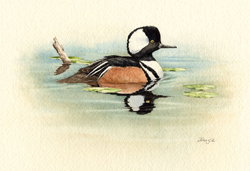Breeding Bird Atlases (BBA)
Find a Bird - BBA1
Breeding Bird Atlas 1 Species Accounts
Hooded Merganser
Lophodytes cucullatus
Egg Dates
Mid-March to June 10
Number of Broods
one

In Massachusetts, Hooded Mergansers have most often been found breeding in the central parts of the Commonwealth, with fewer records from Berkshire, Essex, Bristol, and Plymouth counties, and none from the outer Cape and the Islands. However, they are probably more common than the records would indicate. They are quiet birds, wary and secretive during the breeding season, and their hoarse grunts and chatters are seldom heard. Their preferred habitats are streams, ponds, and freshwater marshes with lots of shrub cover, where they select nest sites in natural tree cavities or Wood Duck nesting boxes. The cautious females use dense cover to keep their broods out of sight, and they doubtless often go undetected even by observant humans.
Hooded Mergansers arrive at their breeding areas as soon as the ice starts to melt. Spring migration peaks in late March, and by late April most northern migrants have passed through. In southeastern Massachusetts, many females start laying eggs in March. They do not bring any nest material into a cavity or box but will rearrange wood chips, decayed wood, leaves, or old nest material present into a shallow, bowl-shaped depression. Eggs (most often ten to twelve) are usually laid at 1- or 2-day intervals, the females covering their eggs with any nest material present before leaving the nest. Often some of the earliest eggs laid in a nest will freeze and crack and will never hatch. Once most of the clutch is laid, the female pulls out down from her breast to cover the eggs, which helps to protect them from freezing before incubation begins and to keep them warm while she is off the nest feeding. Upon her return, she uncovers the eggs by moving the down and reforming the ring around the nest depression.
Male Hooded Mergansers disappear from the breeding area soon after the females start incubation, making the possibility of re-nesting after an initial failure unlikely. Hatching begins after about 32 days of incubation, and the young are usually dry and strong enough to leave the nest within 24 hours of hatching. The female leaves the nest and calls softly until all the young have managed to hop or climb out of the nest cavity and have jumped to the water or ground below.
Hooded Mergansers and Wood Ducks often compete for a natural cavity or nest box. Females of both species may lay eggs in the same nest, with one or the other incubating the eggs. Sometimes the duck that initiated the nest does the incubation, but more often the hen laying the majority of the eggs will do so. Both species have the same incubation period, so either way all of the eggs in a clutch will hatch at the same time. With the warmth and protection of a mother, these mixed broods have a fair chance of survival to flight stage.
Hooded Merganser ducklings feed on the surface of the water or by diving. For the first few weeks of life, they forage for invertebrates such as mayfly and dragonfly larvae. Fish may make up about half the diet of adults, with crustaceans, amphibians, and aquatic insects often making up the other half. Seven Massachusetts brood dates range from May 19 to June 29, with hens accompanied by two to eleven ducklings, and in one case twenty ducklings. The young fledge in about 70 days.
Formerly an uncommon, even rare, transient, the Hooded Merganser is now a regular fall migrant in Massachusetts. Most Hooded Mergansers winter south of Massachusetts, but some usually remain on ponds in southeastern Massachusetts until ice forces them out, after which time they are found in small numbers on coastal estuaries and unfrozen tidal streams.
Map Legend and Data Summary
Atlas 1 data collected from 1975-1979


Note: very uncommon in wooded swamps, Beaver ponds and cranberry bog reservoirs
Richard E. Turner



